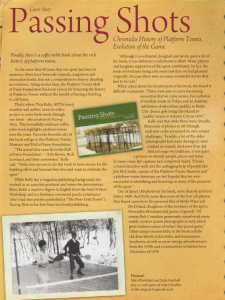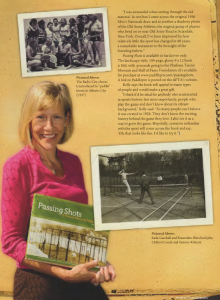Passing Shots – A Pictorial History of Platform Tennis published
In the more than 80 years that our sport has been in existence, there have been rule manuals, magazines and instruction books, but not a comprehensive history detailing its evolution. Along similar lines, the Platform Tennis Hall of Fame Foundation has been a force for honoring the history of Platform Tennis without the benefit of having a building to call home.
That’s where Tina Kelly, APTA board member and author, came in with a project to serve both needs through one book — the creation of Passing Shots. This beautifully rendered coffee table book highlights platform tennis over the years. Proceeds from the sale of the book will go to the Platform Tennis Museum and Hall of Fame Foundation.
“The actual idea came from the Hall of Fame Foundation — Bob Brown, Rich Lombard, and their committee,” Kelly said. “Their concept was to do this book to raise money for the building effort and because they love and want to celebrate the sport.”
While Kelly has a magazine publishing background, has worked as an associate producer and writer for documentary films, holds a master’s degree in English from the Iowa Writers’ Workshop, and is a freelance crossword puzzle constructor (she’s had nine puzzles published in “The-New York Times”), Passing Shots is her first foray into book publishing.
“Although I coordinated, designed and wrote quite a bit of the book, it was definitely a collaborative effort. Many players and longtime supporters of the sport contributed. In fact, the book evolved into being a lot more text than we had planned originally, because there were so many wonderful stories that had to be told.”
When asked about her favorite part of the book, she found it difficult to pinpoint. “There were just so many fascinating mementos that we came across. From photos of rooftop courts in Tokyo and an Austrian exhibition of wheelchair paddle, to Radio City chorus girls being introduced to `paddle’, tennis in Atlantic City in 1937.”
Kelly said that while there were, literally, thousands of photos to sift through, each new cache presented its own unique challenges. “Frankly, a lot of the older photographs had water damage or were cracked or stained. And even if we did find an image we could use, it was quite a process to identify people, places and dates.
In many cases, the captions had completely faded. Thanks to hard detective work and the unflagging help of people like Jim McCready, curator of the Platform Tennis Museum and a platform tennis historian, we feel hopeful that we were successful in identifying and honoring so many of the pioneers of the sport.”
Out of about 180 photos in the book, more than 45 are from before 1960. And Kelly notes that some of the best old photos they found came from the personal files of Molly Ware and Do Deland, daughters of the inventors of the sport, Fessenden Blanchard and James Cogswell. “Of course Bob Considine generously contributed many terrific modern action photographs as well, which gives readers a sense of today’s fast-paced game.”
Other unique memorabilia in the book include old draw sheets, ticket stubs, and tournament brochures, as well as some vintage advertisements from the 1930s and a tournament invitation from December of 1938.
“I was astounded when sorting through the old material. In one box I came across the original 1936 Men’s Nationals draw and in another a shadowy photo of the Old Army Athletes, the original group of players who lived on or near Old Army Road in Scarsdale, New York. Overall, I’ve been impressed by how relatively little the sport has changed in 80 years, a remarkable testament to the foresight of the founding fathers.”
Kelly says the book will appeal to many types of people and would make a great gift. “I think it’d be ideal for anybody who is interested in sports history, but more importantly, people who play the game and don’t know about its vibrant background,” Kelly said. “So many people can’t believe it was created in 1928. They don’t know the exciting history behind the game they love. I also see it as a way to grow the game. Hopefully, someone unfamiliar with the sport will come across the book and say, `Oh, that looks like fun. I’d like to try it.’”
Source: Platform Tennis Magazine, Vol. 12, Issue 3, January, 2011






